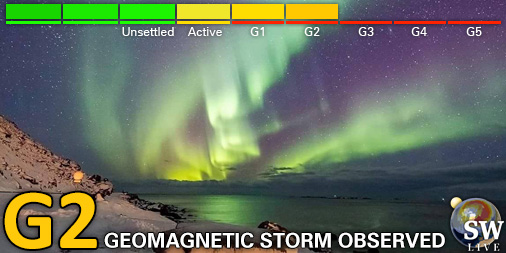Top 50 geomagnetic storms of 2021
On this page you will find an overview of the strongest geomagnetic storms of 2021 together with links to more information in our archive. Storms are ranked by the Disturbance storm-time index (Dst) that is designed to measure the magnetic signature of magnetospheric currents observed in the equatorial regions. The Dst index is provided by the World Data Center for geomagnetism in Kyoto.
Current data suggests there is a high possibility for aurora to appear at the following high latitude regions in the near future
Gillam, MB, Whitehorse, YT, Yellowknife, NTFairbanks, AK, Utqiagvik, AK
Current data suggests there is a moderate possibility for aurora to appear at the following high latitude regions in the near future
Edmonton, AB, Iqaluit, NU, Saskatoon, SKNuuk
Anchorage, AK, Juneau, AK
Current data suggests there is a slight possibility for aurora to appear at the following middle latitude regions in the near future
Calgary, AB, Winnipeg, MBLatest news
Latest forum messages
Support SpaceWeatherLive.com!
A lot of people come to SpaceWeatherLive to follow the Solar activity or if there is a chance to see the aurora, but with more traffic comes higher costs to keep the servers online. If you like SpaceWeatherLive and want to support the project you can choose a subscription for an ad-free site or consider a donation. With your help we can keep SpaceWeatherLive online!
Latest alerts
07:15 UTC - Type IV Radio Emission
Begin Time: 08/11/2025 04:48 UTC
05:15 UTC - Geomagnetic activity
Minor G1 geomagnetic storm (Kp5) Threshold Reached: 04:01 UTC
03:15 UTC - Geomagnetic activity
Moderate G2 geomagnetic storm (Kp6) Threshold Reached: 02:01 UTC
02:48 UTC - Hemispheric Power Index
The OVATION model predicts the Hemispheric Power Index to reach 100GW at 03:23 UTC
02:45 UTC - Geomagnetic activity
Minor G1 geomagnetic storm (Kp5) Threshold Reached: 01:35 UTC
Space weather facts
| Last X-flare | 2025/11/04 | X1.1 |
| Last M-flare | 2025/11/07 | M1.7 |
| Last geomagnetic storm | 2025/11/07 | Kp5+ (G1) |
| Spotless days | |
|---|---|
| Last spotless day | 2022/06/08 |
| Monthly mean Sunspot Number | |
|---|---|
| October 2025 | 114.6 -15.2 |
| November 2025 | 79.7 -34.9 |
| Last 30 days | 94.3 -34.9 |








